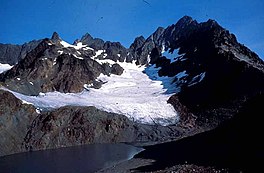Anderson Glacier
| Anderson Glacier | |
|---|---|
 Anderson Glacier, photographed by National Park Service, date unknown | |
| Type | Mountain glacier |
| Location | Mount Anderson, Olympic National Park, Jefferson County, Washington, USA |
| Coordinates | 47°42′48″N 123°20′06″W / 47.71333°N 123.33500°W[1] |
| Terminus | Proglacial lake |
| Status | Severe retreat/extinct |
Anderson Glacier was a glacier located in a cirque south of Mount Anderson in the Olympic Mountains and Olympic National Park.[2] The southward-facing glacier starts on the steep headwalls of the cirque at about 6,200 feet (1,900 m) to 6,000 ft (1,800 m). It flows down to about 5,240 ft (1,600 m) before terminating. Meltwater from the glacier enters a lake at about 4,949 ft (1,508 m) before tumbling down a steep cliff.[2] Between 1927 and 2009, Anderson Glacier lost more than 90 percent of its surface area.[3] By 2011, the glacier was gone.[4] The lack of glacial meltwater from the Anderson Glacier has caused the Quinault River to reach new recorded lows.[5]
See also
References
- ^ "Anderson Glacier". Geographic Names Information System. United States Geological Survey, United States Department of the Interior. Retrieved 2012-10-06.
- ^ a b Mount Steel, WA (Map). TopoQwest (United States Geological Survey Maps). Retrieved 2012-10-06.
- ^ "Glaciers and Climate Change". National Park Service. Retrieved 2012-10-06.
- ^ Ahearn, Ashley (December 2, 2015). "Facing Rising Waters, A Native Tribe Takes Its Plea To Paris Climate Talks". NPR.
Five years ago the Anderson Glacier, which contributes cool water to the Quinault River at critical times of year, disappeared for good.
- ^ Ahearn, Ashley (December 2, 2015). "Facing Rising Waters, A Native Tribe Takes Its Plea To Paris Climate Talks". NPR.
But without the glacier, the Quinault River was lower than ever before recorded. So low that while walking through a newly exposed stretch of river bed, one tribal member accidentally stubbed his toe on what turned out to be a mastodon jaw that may have been submerged since the last ice age.
Further reading
- Anderson Glacier, Olympic Mountains, Washington Disappears (January 9, 2015)

